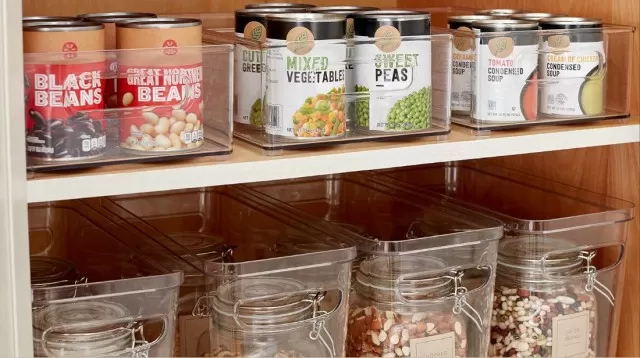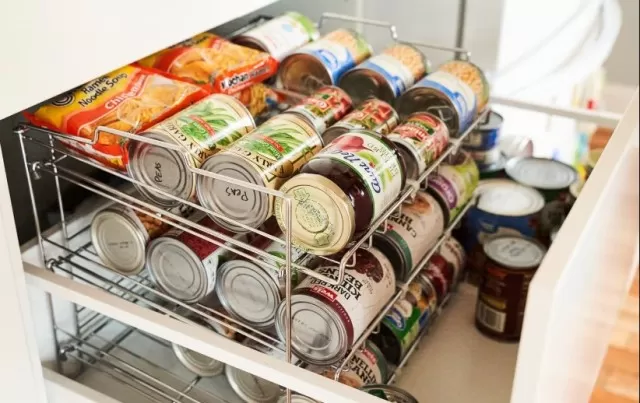Canned food is a common pantry essential that simplifies meal preparation, even during busy weeknights.
However, due to their size, most cans can occupy a significant amount of space in cabinets and drawers.
Hence, it is crucial to establish an organized system for storing them. Properly organizing canned goods not only maximizes space utilization but also ensures easy access whenever needed.
Moreover, it helps minimize food waste by preventing cans from getting lost at the back of the pantry and expiring before they can be used. Additionally, a well-organized storage system enables you to promptly identify any cans that show signs of spoilage, such as swelling or rust accumulation.
To prevent spoilage, it is advisable to store canned goods in a cool and dry environment, away from direct sunlight.
Suitable storage locations include reach-in or walk-in pantries, kitchen cabinets, or drawers. Now, let’s explore various options for organizing canned food within these spaces.
6 Ways to Organize & Preserve Canned Food

Explore the Stadium Seating Approach for Canned Food Organization
Consider implementing the Stadium Seating Method, which is a highly effective technique for arranging your cans.
Although not a formal term, it is commonly used by professional organizers to describe a tiered organizer system that allows you to have a clear view of all your cans. Even those tucked away at the back will be easily visible on a tiered riser.
Risers are available in various materials such as acrylic, bamboo, and metal, and many of them can be expanded or adjusted to fit the size of your shelves, whether they are in a pantry or a cabinet.
In addition to organizing your cans, this method helps you avoid buying excess cans or forgetting what you already have, ensuring that you have a clear inventory of your canned goods.
Deliberate the Option of a Lazy Susan
The suitability of a lazy Susan for storing your canned food depends on the quantity you usually stock.
Cans are particularly well-suited for placement on lazy Susans because of their round shape, which maximizes the utilization of space. However, keep in mind that a small turntable can only accommodate a limited number of cans at a time.
Therefore, if you typically maintain a small stock of cans and use an appropriately sized lazy Susan, this can be an excellent choice. Simply place the lazy Susan on a shelf and give it a spin to effortlessly locate and retrieve the can you need.
Conversely, if you tend to accumulate a large number of canned goods, it is advisable to opt for alternative storage options that can accommodate a greater quantity.

Implement Drawer Dividers for Organizing Canned Foods
When dealing with a substantial collection of cans, it is essential to use a sturdy bottom drawer for this organization method.
Arrange your cans in neat rows within the drawer, grouping them by type—keeping soups, vegetables, beans, and other categories separated as much as possible. Since you can only see the top of the cans when the drawer is open, it is helpful to attach label tape to the inside lip of the drawer to indicate the different categories.
While the cans are likely to stay in place, if you have enough space, consider incorporating drawer dividers between the rows to prevent them from sliding around. Additionally, place the cans with the closest expiration dates towards the front for easier access.
Optimize Empty Wall Space for Storage
If you are fortunate to have a walk-in pantry, take advantage of any available blank walls within it or on the inside of the door.
This unused wall space can serve as an excellent location to store your canned food. Install a durable metal rack with baskets, utilizing the vertical space from floor to ceiling.
Organize the cans within the baskets by grouping them according to type. This arrangement allows for quick access to your canned goods without sacrificing any shelf or drawer space.
Furthermore, storing the cans behind closed doors helps reduce visual clutter while keeping them in a cool and dry environment.

Benefit from Can Dispensers
When dealing with deep shelves, employing a can dispenser can greatly enhance the utilization of space.
These organizers typically consist of three levels that can be adjusted to accommodate cans of different sizes. Customize the bottom rows to fit larger cans like diced tomatoes, while reserving the top row for smaller cans such as tomato paste.
By categorizing your canned goods in this manner, you can easily keep track of when you’re running low on a specific product. As you remove a can from the front of the dispenser, the remaining cans will roll forward, ensuring easy access and facilitating the rotation of your stock.
Utilize Bins and Baskets for Easy Storage
Finally, simplify your canned food storage by utilizing open containers such as bins and baskets.
Line them up along a shelf or inside a drawer to keep your cans organized. You can dedicate specific bins for different categories, such as one for baking items like pumpkin puree, cherry pie filling, and condensed milk, and another for canned seafood.
Attach labels to each bin for easy identification, and whenever you need something, simply reach into the appropriate bin.
What makes this method particularly advantageous is that it helps prevent excessive stockpiling.
While it’s good to have extra cans on hand, it’s also easy to get carried away during sales and end up with more than you actually need. By maintaining an organized system for your canned food, you eliminate the guesswork of what you already have and when it’s time to restock.
*The information is for reference only.